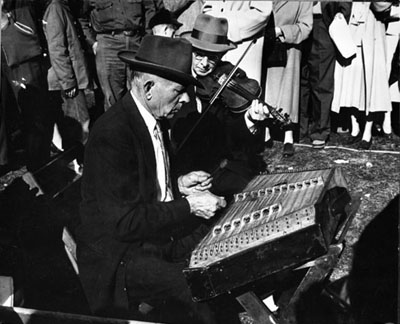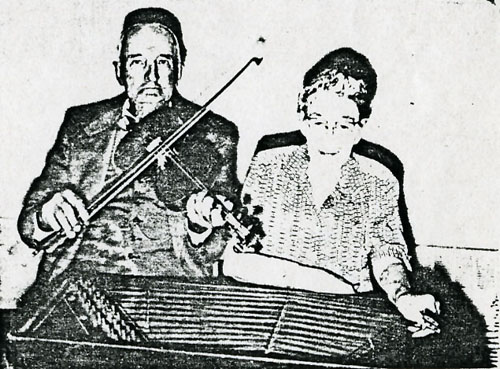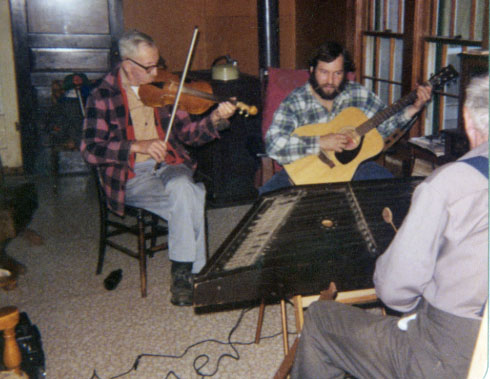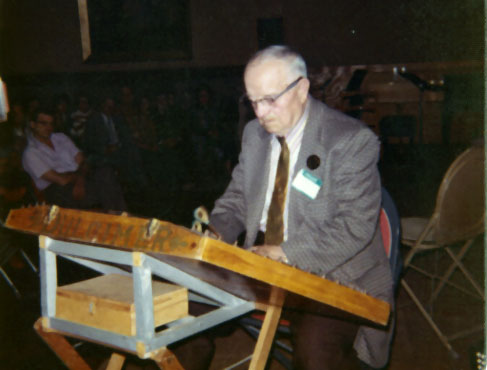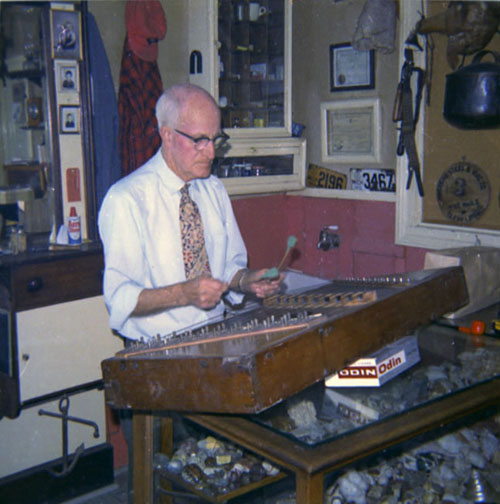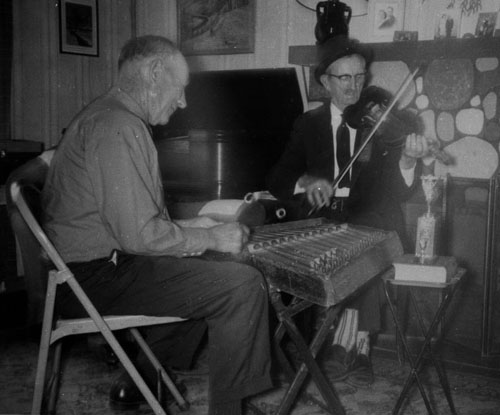THE DULCIMER AS ACCOMPANIMENT FOR THE FIDDLE AND OTHER INSTRUMENTSThe revival of the dulcimer has, of course, witnessed the instrument being used in ensemble with other instruments. For a long time it was largely mainly a solo instrument, the other instruments being used to accompany the dulcimer. In the last forty years of this revival, its function has varied, yet the old tradition that I want to discuss here remains unknown and forgotten. Virtually everything I originally learned about the dulcimer began at home, from my father and uncle. I looked in books but found very little. As I played more and more in public during the 1970s, I was eager to learn about the tradition, and listeners became my chief source of information. For the vast majority, whether in Michigan or elsewhere, the instrument was completely new. In a few years, I could account for the small number of active players. But regularly someone in the crowd, usually elderly (or at least much older than I), would describe having seen one or having known someone who played. Over the years enough of these incidents accumulated for me to provide a pretty good picture of the American (or at least one regional American) dulcimer tradition. The typical player I heard about was a rural male (although female players were not uncommon) who played the dulcimer and frequently other instruments, usually the violin, but sometimes also the mouth organ, banjo, piano, etc. He typically played only a limited number of tunes on the dulcimer (though again there were exceptions) and used it mainly as an accompanying instrument. For example, he might play a lot of tunes on the fiddle but mainly play accompaniment on the dulcimer. One common pattern was for siblings to play together. Another was two young men, working, say, as farm hands, who played together at informal parties for other young people to dance. In my book The Hammered Dulcimer: A History (Lanham, Md.: Scarecrow Press, 2001) I have gone into some detail about the manufacture of the instrument during the period from about 1845 to 1880. I noted that many of the purchasers at this time seemed to regard the instrument as a cheap piano, and, in fact, some of the manufacturers called it the “piano-dulcimer.” Farm families bought it as an affordable luxury in the same way that more genteel, wealthier families bought pianos----as a symbol of culture that their daughters might cultivate. Unlike the piano, however, which required formal instruction, the dulcimer was an easy instrument which one could learn without a teacher. Thus many of the original owners of these manufactured dulcimers were women, born around 1840 or 1850, and some continued to play until their last years in the early 20th century. But in an area stretching roughly from the western edge of the Adirondacks in New York State, south to northern Pennsylvania, westward through the northernmost tier of Ohio, into the Lower Peninsula of Michigan, through northwestern Indiana, up into parts of Wisconsin and Iowa, then gradually fading in Minnesota, the Dakotas, and Nebraska, the dulcimer style in the latter part of the 19th century and in the early 20th century shared the characteristics of the “typical” player I described above. It is hard to pinpoint the beginnings of the dulcimer-fiddle ensemble in America. Certainly it had begun by the end of the first half of the 19th century. Stephen Bennett (1811-1894), a shoemaker and farmer of Albion, Orleans County, New York, and recalled by Bruce Wight, of Batavia, New York, in a 1925 letter to Henry Ford, as a “famous dance fiddler,” gave lessons during the winter of 1850 to Bruce’s uncle Perry Wight (1831-1862) on both violin and dulcimer and showed him how to make the instrument as well. Bennett moved not long after to Bethel Township, Branch County, Michigan, where he continued to make dulcimers. At the Branch County fair in 1854, he exhibited one. he had made. At least one dulcimer bearing the stenciled inscription “S. Bennett” has turned up in that area. Wight saved Bennett’s manuscripts of tunes with right and left-hand marks for striking, as well as a dulcimer “second” part. (Acc. 285, Box 581, Benson Ford Research Center; James W. Kimball, Sackett’s Harbor: Nineteenth-Century Dance Music from Western New York State [Rochester, N.Y.: Sampler Records Ltd., 1994]). Clearly the style was common in Western New York by 1850, and it followed migrants as they then traveled westward, mainly towards Michigan and Wisconsin. The small taverns dotted along the road between Pontiac and Lapeer, Michigan, after the Civil War, featured music, usually violin and dulcimer, to draw the teamsters hauling lumber. The violin and dulcimer, played by J. Wesley Phelps (1830-1916) and Albert Race (1845-1895), was the core of the group that played for the dances outside of Detroit that Henry Ford attended as a youth. In 1926, when the fiddler Jep Bisbee played in Ludington, Michigan, local organizers hired Civil War veteran Dan Shoup to play the dulcimer with him, even though he hadn’t touched it in many years. In Wisconsin, an ensemble of violin, dulcimer, and bass viol was common in some places before the Civil War. Perhaps the style that developed in New York was merely one example of a style that, although obscure and fleeting, in earlier years was spread over a wider area. For example, in 1878, a writer visiting Appling, Georgia, could evoke the Revolutionary period by describing an entertainment at a mansion where “violin and dulcimer strike up the measured symphony of the stately minuette [sic].” Perhaps this style of playing accompaniment, called “chording,” was invented anew in New York’s “Burnt Over District,” but I doubt it. More likely, it was brought to America from Europe. But from where? The only evidence of dulcimer playing associated with dancing in Colonial America or in the early republic comes from German communities in South Carolina and southeastern Pennsylvania, both of which are outside this core region. There was a sizeable immigration of German Palatines into the Mohawk Valley in the 18th century. However, migration or immigration into western New York State in the early 19th century was primarily from New England and eastern New York. The 1850 census shows that in western New York the largest countries of foreign birth were Ireland and England. Most of the Irish immigration was recent, due to the Potato Famine. German immigration was relatively small. There is evidence for the dulcimer being associated with fiddles in England as early as 1662, when the diarist Samuel Pepys mentioned seeing it “among the fiddles.” Joseph Addison, in 1709, describes young London lawyers “mightily taken with the union of the dulcimer, violin, and voice” at taverns at midnight. During the 18th century, the instruments appeared together in street music, and in the early 19th century, fiddle and dulcimer accompanied dances in Sheffield. On the whole, however, although the fiddle-dulcimer ensemble was common enough, it seems not to have been widely popular in England during the early 19th century. In Ireland, however, it was a different story. Between about 1770 and 1830, it obviously was very popular, especially in the more anglicized regions around Dublin and in Ulster. There are many reports of it being played with the fiddle at balls, both at gentlemen’s country seats and in the cities. The establishment in Dublin, in its “State Music,” even retained a dulcimer player with an annual salary so he (and the other instrumentalists) could be on call for state balls. Although fiddle and dulcimer is the most typical combination seen in these references, bagpipes or another fiddle were sometimes added, and more fashionable balls in the Napoleonic period might also include French horns, cello, and tambourine, in addition to the basic fiddle and dulcimer. Then, after 1830, the popularity of the dulcimer declined to the point where, by 1900, it was rare. Whether the style came to rural New York state from England or Ireland is probably not something that can be conclusively documented. Perhaps a single immigrant and dulcimer maker used it at balls and dances in the early 19th century and popularized it. In any case, it was one of many dulcimer accompaniment styles in European tradition. Other such styles had separate origins. In the Alps, the Hackbrett ("chopping block") arose in the 15th century and accompanied the fiddle that survives most notably as Appenzeller Streichmusik. In Galicia (eastern Poland and western Ukraine), both Jews and Gentiles took up the instrument in the 16th century, probably as accompaniment to the ensemble of two fiddles of Byzantine origin then in use. This seems to have been the origin of the Ukrainian troista muzyka on the one hand, and, via Jewish musicians, of the Bohemian Jewish ensemble of the 17th century. The latter influenced the instrumentation of the wedding music of the Germans who settled near the Volga River in Russia and the Hungarian Gypsy orchestras and later those of Romania. The Gypsy musicians of Eastern Europe are professionals, handing the trade down from father to son. This was also largely the case with German Musikanten, who, in some places in the early 19th century, had to purchase licenses which would allow them to legally continue their trade, largely to play at wedding festivities, which could last for several days. In England and Ireland, some dulcimer players regarded themselves as professionals, even if they played on the streets, as well as at dances and to accompany puppet shows. In the United States, professional musicians (with rare exception) did not use the instrument. Professionals, outside of the small number of mostly European-born music masters and theatre musicians in cities, consisted mainly of free and enslaved black fiddlers. In the period from about 1800 to 1830, they were frequently accompanied by tambourine players. This was the typical ensemble in New England and eastern New York when country dances were all the rage in the early 19th century. Then, as cotillions (early square dances) increased in popularity in the 1820s and 1830s, a different kind of ensemble, associated with cotillions, grew in popularity. Some consisted of black musicians, but more were white, and eventually many were immigrants, mostly from Germany. These ensembles, originally called “cotillion bands,” later “quadrille bands,” and, finally, after the Civil War, “orchestras,” traveled distances to play at larger balls held at hotels in the wintertime, especially on holidays. Such ensembles wore sharp, formal clothes and prided themselves on having the latest music, even if they did not always read well. The key feature of these ensembles was not the addition of brass and reed instruments, although that was a typical feature. It was the presence of the second violin, which, with its double stops, played an accompanying role in the ensemble. The size of these ensembles varied, but at a minimum there would be a lead and a second violin. The third instrument would probably be a bass (or bass viol or cello). Then clarinet, cornet, and other instruments might fill out the ensemble. In urban areas, the leader might offer to contract for as many as twelve musicians, depending on the occasion. By 1900, publishers catered to these groups by issuing dance music in stock arrangements for large ensembles that would work equally well for three or four parts. 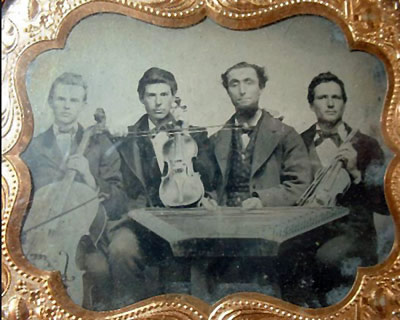
Occasionally quadrille bands used a dulcimer. The music that accompanied a “prom” at the Mukwonago House near Madison, Wisconsin, in 1859, consisted of two violins and dulcimer. In 1866, Heath’s Cotillion Band advertised in the Smethport, Pennsylvania, newspaper McKean Miner that it consisted of four pieces, violin (presumably two of them), clarinet, and dulcimer and would play at balls and parties. In 1911, Dan Camp recalled that Payne and Whitmore’s band, active during the 1860s in the Waukesha, Wisconsin, area, consisted of first and second violin, clarinet, and bass viol, but introduced on several occasions a dulcimer, remarking, however, that “it was a job to keep the thing in tune and it besides was unhandy to carry ‘round the circuit in the rig we had.” Around 1880, in Adams, Jefferson County, New York, the “Happy Band” consisted of first and second violin, dulcimer, flute, and bass viol. The group that played for the dances at the roadside hotels outside Detroit that Henry Ford attended in his youth certainly was a professional one. However, the dulcimer was mostly found in rural areas associated with amateur musicians. Players might be members of a large family, who played with each other regularly, where the patriarch of the family had purchased a dulcimer with the intention that it be used by his children. Or the player might be a young farm laborer who learned it in order to be able to accompany a fiddler for dancing in the neighborhood. Public performances might be at a house party or at a party at a local Grange hall. Thus from about 1870 until World War II and later, the typical venue for the instrument, when it appeared outside the home, would be at small, rural halls, community centers, and local fairgrounds. 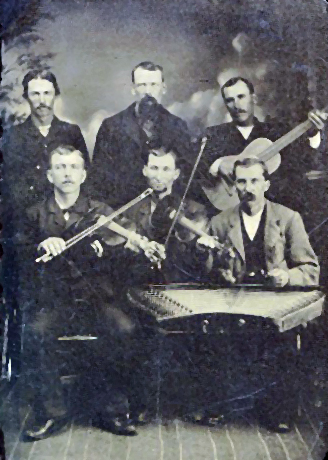
The players represented here by recordings made between about 1950 and 1980 are those whose families acquired the instrument in the Civil War period or later and preserved the tradition long enough for us living in the 21st century to enjoy it today. The revival began in the late 1960s and 1970s with little influence from the old-timers, and it gradually progressed well beyond the level of the Civil War-era boom. Nevertheless, we need to hear and understand the older music in order to gain a greater understanding of the instrument's place in American musical history.
LIST OF AMERICAN ENSEMBLES WITH DULCIMERSThe list below has been compiled from a variety of sources: local histories, newspapers, and word of mouth. No list of this sort can claim to be comprehensive; its purpose is merely to suggest a regional style and the geography and history of that style. When the dulcimer player also played the violin, I assume that he was able to play second on the dulcimer. PennsylvaniaFrenchville, Clearfield Co.: Emile Cowdin, violin, George Hay, dulcimer, at a dance, 1878. Moose Park, McKean Co.: Roland C. Freer (1861-1941) played fiddle and dulcimer, also performed Punch and Judy shows. 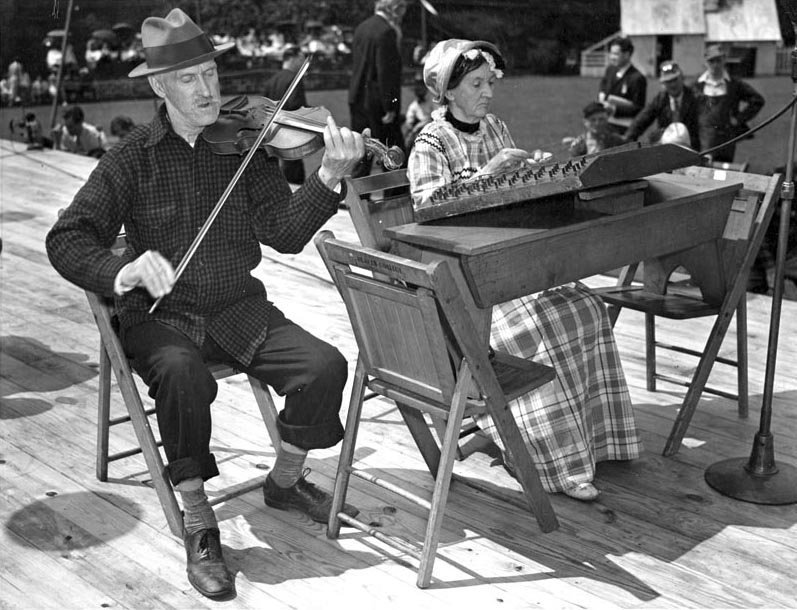
Liberty Twp., Tioga Co.: Ada Bradley (1876-1952), accompanied her brother Herbert (1872-1966), who played violin; they played at the 8th National Folk Festival in Washington, D.C. (1939). New York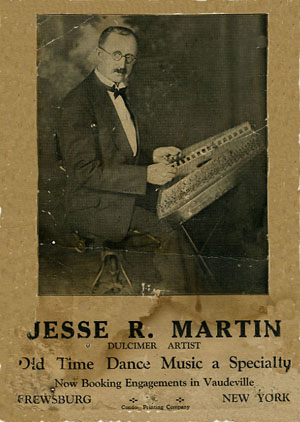
Cherry Creek, Chautauqua Co.: Ethan Wilcox (b. 1862) played dulcimer with J. L. Clark, violin, at an Oddfellows' lodge program (1902-1903). Frewsburg, Chautauqua Co.: Jesse R. Martin (1854-1939); played on a raft at Warren in 1880 with two fiddlers; played for dances in 1920s around Jamestown with fiddler Charles G. Locke of Salamanca. Ohio
Colebrook, Ashtabula Co.: The music at dances above J. C. Rodgers’ store after 1906 was generally fiddle and dulcimer.
MichiganAllegan, Allegan Co.: Cora Torrey (1864-1944), played dulcimer with husband Eri B. Torrey, fiddler, at dances at Trowbridge Township Grange hall, 1920s. 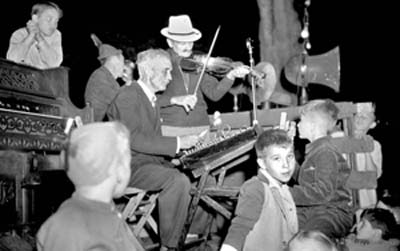
Ganges Twp., Allegan Co.: Harry Keirnan (1882-1967), played with brother Thomas W. Keirnan (1878-1949) at dances at the I.O.O.F. Hall in Glenn. 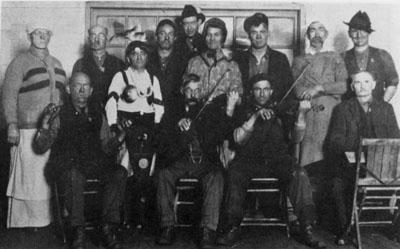
Argentine Twp., Genesee Co.: Lewis C. Sturgis, Jr. (1860-1940) accompanied brother Mark Sturgis (1854-1934), a fiddler, as well as most other contestants, at fiddlers’ contest in Flint (1926). 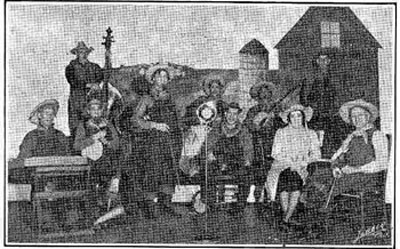
Lansing, Ingham Co. Lew Dougherty's Old-Timers, who appear to have played on the radio as well as for weekly "modern and old-time" dances at the Old Spinning Wheel Dance Hall, near the State Capitol, consisted of ten people, whose instruments included two violins, two banjos, dulcimer, bass, and others (c.1930). 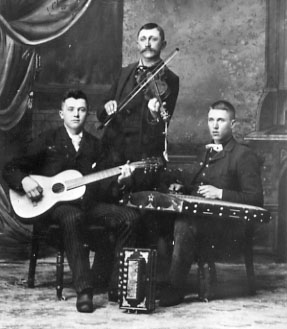
Geneva Twp., Midland Co.: Curtis O. Render (1874-1950), played dulcimer and accordion with A. Otis Fish, fiddle, and Lewis Dunlap, guitar (c.1899). 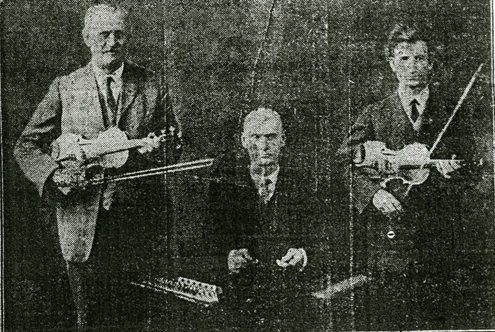
Hazelton Twp., Shiawassee Co.: Henry L. Amidon (1866-1950), played violin and dulcimer with his own old-time orchestra, active in 1930s-1940s. 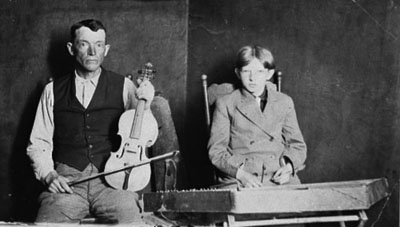
Greenwood Twp., Wexford Co.: Welcom Toms (1871-1960) played the fiddle and dulcimer and played with his son Allan (1897-1969). IndianaCoolspring Twp., LaPorte Co.: Emil Paschack (1879-1941) played dulcimer with his brother, a fiddler. Kankakee Twp., La Porte Co.: Dennis L. Culveyhouse (1880-1958) played with George Wilcox, violin, and Edward King, banjo, at Three Oaks pioneer’s day celebrations (1933, 1935), and with Wade Nash instead (1933). WisconsinRice Lake, Barron Co.: William McDonald (b. c.1854) played at a fiddlers’ contest (1927). 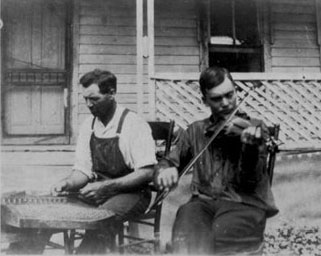
Dekorra Twp., Columbia Co.: Franklin E. Cross (1871-1966), dulcimer, James C. Cross (b. 1879), violin, also Archie (1881-1944), played in a family dance orchestra made up of violin, dulcimer, and bass viol. IllinoisFulton/Schuyler/McDonough Counties (Flat Woods area): The dulcimer seems to have been fairly popular at the turn of the 20th century, due mainly to the efforts of Daniel L. Van Antwerp (1848-1925), a native of Rome, Michigan, whose family settled in Vermont, Fulton County, Illinois, in 1860, where he made the instrument, as well as violins, and sold them to local customers. There were more players than those listed here. Although they used the dulcimer with the fiddle at local dances, “chording” seems to have been unknown. Thanks to Bill Robinson for much of this information. IowaTurkey River, Clayton Co.: William A. White (1871-1915) made three; son Martin (1900-1983) played dulcimer with brothers Reuben and Dewey on fiddle and bass at parties and dances, at Millville Hall MinnesotaWood Lake Twp., Yellow Medicine Co.: Ella B. Rhode (b. 1894) reminisced that her two uncles, who played violin, and aunt, who played dulcimer, would come to visit, and she would chord on organ. Utah Roosevelt, Duchesne Co.: Ammon B. Reynolds (1853-1916) played dulcimer with Bill Taylor, violin, at dance (1906); he sometimes accompanied Henry Howard, accordion (Salt Lake County) North Carolina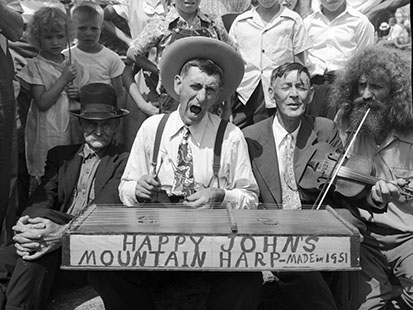
Caldwell Co.: John Wesley ("Happy John") Coffey (1877-1967) made and played a rectangular dulcimer he called a "mountain harp," playing with his fiddler brother Roby Columbus Coffey (1881-1964). This is a rare example of the instrument being used in the Southern Appalachian region; it was once more common to the east in North Carolina. "Happy John" was a regular feature in the 1940s and 1950s at the "Singing on the Mountain" gospel festival on Grandfather Mountain, at which this photograph was taken.
Recordings
1. [My Love She's But a Lassie Yet] played by Lewis Swan, violin, accompanied by Jack Swan, dulcimer. Recorded by Lewis Swan, about 1972, at Corry, Pennsylvania. 2. Rickett's Hornpipe played by Lewis Swan, violin, accompanied by Jack Swan, dulcimer. Recorded by Lewis Swan, about 1972, at Corry, Pennsylvania. 3. [Ring, Ring the Banjo] played by Lewis Swan, violin, accompanied by Jack Swan, dulcimer. Recorded by Lewis Swan, about 1972, at Corry, Pennsylvania.
4. [Smash the Windows] played by Keston Peters, violin, accompanied by Luther Battles, dulcimer, and unknown, tuba. Recorded probably about 1960 by at Burton, Ohio. 5. Golden Slippers played by Keston Peters, violin, accompanied by Luther Battles, dulcimer, and unknown, tuba. Recorded probably about 1960 at Burton, Ohio. 6. Waltz played by Keston Peters, violin, accompanied by Luther Battles, dulcimer, and unknown, tuba. Recorded probably about 1960 at Burton, Ohio.
7. Miner's Quadrille played by Archie Barnes, violin, accompanied by Elizabeth Barnes Palen, dulcimer. Recorded in 1957 near Okemos, Michigan. Taped in 1966 by Charles Delamater for the Okemos Historical Society. 8. Old Maids' Waltz played by Archie Barnes, violin, accompanied by Elizabeth Barnes Palen, dulcimer. Originally recorded on an acetate disc in 1957 near Okemos, Michigan. Taped in 1966 by Charles Delamater for the Okemos Historical Society.
9. Haste to the Wedding played by Bill Bigford, violin, accompanied by Al Hober, dulcimer, and Paul Gifford, guitar. Recorded at Pewamo, Michigan, September 28, 1980. Mr. Hober called this tune Finnegan's Wake. Neither Bill nor Al had played together before, even though they didn't live very far from each other. I was playing one night with Bill in a bar in Portland when a customer came up and told me about Al. 10. [McLeod's Reel] played by Bill Bigford, violin, accompanied by Al Hober, dulcimer. Recorded at Pewamo, Michigan, September 28, 1980. Neither knew the name of this tune; Al also played the melody of the tune on the dulcimer. 11. Waltz played by Bill Bigford, violin, accompanied by Al Hober, dulcimer, and Paul Gifford, guitar. Recorded at Pewamo, Michigan, September 28, 1980. 12. On the Road to Boston played by Paul Gifford, violin, accompanied by Pete Seba, dulcimer, and Will White, guitar. Recorded in Ravenna Township, Muskegon County, Michigan, September 4, 1981. Pete Seba was 98 years old and had lived in the same house since he was a teenager. Al Hober was a former neighbor of his, and their style of playing was very similar. The tune was one that Hober played on the mouth organ.
13. Tune in 6/8 played by Peter Reames, button accordion, accompanied by Eleanor Sorenson, dulcimer. Recorded at Original Dulcimer Players Club meeting, Interlochen, Michigan, May 1973. Eleanor was his granddaughter, and she played exactly the same way her grandfather did. 14. Turkey in the Straw played by Peter Reames, button accordion, accompanied by Eleanor Sorenson, dulcimer. Recorded at Original Dulcimer Players Club meeting, Interlochen, Michigan, May 1973. 15. Peek-a-Boo Waltz played by Peter Reames, button accordion, accompanied by Eleanor Sorenson, dulcimer. Recorded at Original Dulcimer Players Club meeting, Interlochen, Michigan, May 1973.
Examples of "Chording"
1. Frank Stevens, recorded at Sand Lake, Michigan, October 1971. Keys of D, G, and C. 2. Fenton Watkins, recorded at Birmingham, Michigan, 1976 by Bill Webster. Key of A. 3. Pete Seba, recorded at Ravenna Township, Muskegon County, Michigan, September 4, 1981. Key of A in 6/8 and then 3/4 in G. 4. Peter Reames, recorded at Original Dulcimer Players Club meeting, Midland, Michigan, September 25, 1971. 5. Delbert Schrader, recorded at Original Dulcimer Players Club meeting, Midland, Michigan, September 25, 1971.
6. Elgia Hickok, recorded at Original Dulcimer Players Club meeting by Eugene A. Cox, Barryton, Michigan, September 28, 1963. 7. Allan Toms, recorded at Original Dulcimer Players Club meeting by Eugene A. Cox, Barryton, Michigan, September 28, 1963, demonstrating 2/4 chords in F, B flat, C, G, and D minor. He tuned his dulcimer a full step lower than usual, allowing him those.
|
||||||
|
